Redesigning Uber for Business
When I joined Uber for Business three years ago, we were a very small and scrappy group with a clear mission: to simplify ground transportation for business travelers. We realized that a lot of people were already using Uber on business trips, and we wanted to develop products and experiences that spoke directly to those users. From my first day, I was impressed with the entire team and our ability to move quickly. It was exhilarating to be surrounded by great people, building something that would provide real value to millions of people — creating a huge impact in a relatively short time.
Three years later, our team has grown to over 100 people, serving 65,000 companies worldwide. But even as we’ve grown, I’ve been struck by how much it still feels like working on a small team: we continue to move quickly, and we are still able to interact with and learn from our users and their concerns. Our launch builds on three important things in particular that we’ve learned along the way:
- “Uber for Business” means different things to different companies. Soon after first launching Uber for Business, we saw companies setting up multiple accounts for different groups of people to access different travel programs. For example, a sales team may need rides available in every city, a new office employee might need rides from the train station to the office, and people working late could need rides home.
But the need for multiple accounts complicated things for our users. One car manufacturer we work with set up 35 different accounts for dealerships to book rides for customers within each region. Managers and administrators were having to juggle multiple accounts — exactly the problem we were trying to solve while building Uber for Business in the first place!
Our recent launch has redesigned our whole product so that a single account can set up multiple travel programs, each one with specific settings for different individual and group users. And it’s not just for employees: for example, recruiters can use Uber Central to book rides for job candidates, or to give visiting partners and clients door-to-door service while they are in the city. With this redesign, we’ve eliminated the need to jump between accounts — an administrator can log in to one account and get a bird’s eye view of all Uber usage across their entire organization. We redesigned our dashboard to create a more consistent experience when switching between our different products (Uber for Business, Uber Central)
- Our clients want access to services beyond rides.
When most people today think of Uber, they think of pushing a button and getting a ride. However, over the years we’ve seen companies using Uber’s app in many different ways other than getting themselves around town. That has inspired us to create new services to better fit their needs.
Uber Central is a great example of this: it began as a product spun up after we saw how some companies (hotels, for example) were using multiple phones to order rides for clients and patrons. This not only required creating multiple accounts, but also using multiple devices to book rides simultaneously. Uber Central fixes that: it empowers any mobile phone or front desk within an organization to order multiple rides for guests that are paid for by the company.
Our recent changes to Uber for Business make it easy for us to give companies access to new services like Uber Central. Companies can now give specific people, like front desk attendants, office managers, and recruiters access to this new service from Uber.
Continue reading: https://medium.com/uber-design/redesigning-uber-for-business-a20b2744e2d4
• Rebuilding Uber for Business – as described in Medium.



